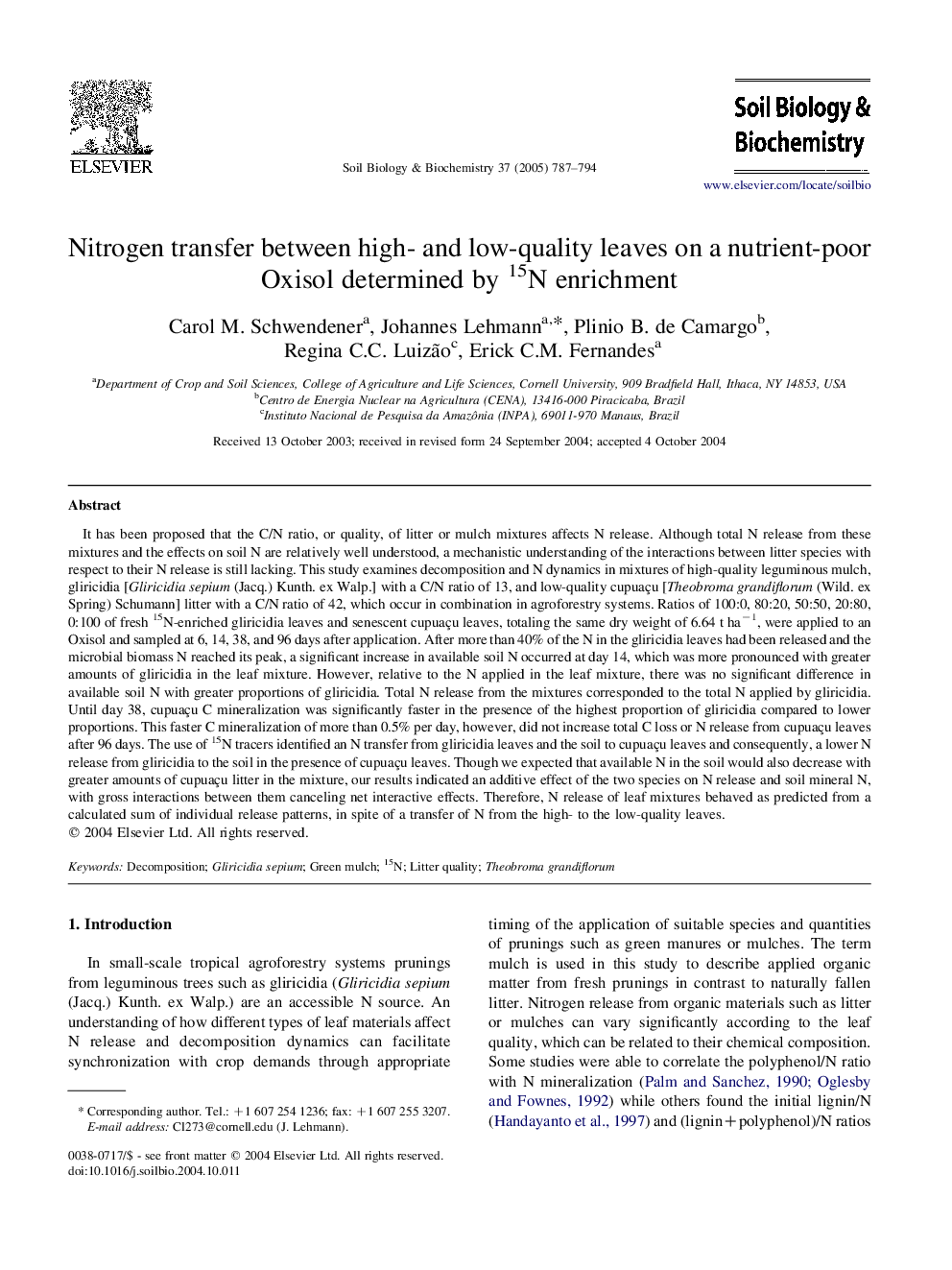| کد مقاله | کد نشریه | سال انتشار | مقاله انگلیسی | نسخه تمام متن |
|---|---|---|---|---|
| 10846300 | 1070047 | 2005 | 8 صفحه PDF | دانلود رایگان |
عنوان انگلیسی مقاله ISI
Nitrogen transfer between high- and low-quality leaves on a nutrient-poor Oxisol determined by 15N enrichment
دانلود مقاله + سفارش ترجمه
دانلود مقاله ISI انگلیسی
رایگان برای ایرانیان
کلمات کلیدی
موضوعات مرتبط
علوم زیستی و بیوفناوری
علوم کشاورزی و بیولوژیک
دانش خاک شناسی
پیش نمایش صفحه اول مقاله

چکیده انگلیسی
It has been proposed that the C/N ratio, or quality, of litter or mulch mixtures affects N release. Although total N release from these mixtures and the effects on soil N are relatively well understood, a mechanistic understanding of the interactions between litter species with respect to their N release is still lacking. This study examines decomposition and N dynamics in mixtures of high-quality leguminous mulch, gliricidia [Gliricidia sepium (Jacq.) Kunth. ex Walp.] with a C/N ratio of 13, and low-quality cupuaçu [Theobroma grandiflorum (Wild. ex Spring) Schumann] litter with a C/N ratio of 42, which occur in combination in agroforestry systems. Ratios of 100:0, 80:20, 50:50, 20:80, 0:100 of fresh 15N-enriched gliricidia leaves and senescent cupuaçu leaves, totaling the same dry weight of 6.64 t haâ1, were applied to an Oxisol and sampled at 6, 14, 38, and 96 days after application. After more than 40% of the N in the gliricidia leaves had been released and the microbial biomass N reached its peak, a significant increase in available soil N occurred at day 14, which was more pronounced with greater amounts of gliricidia in the leaf mixture. However, relative to the N applied in the leaf mixture, there was no significant difference in available soil N with greater proportions of gliricidia. Total N release from the mixtures corresponded to the total N applied by gliricidia. Until day 38, cupuaçu C mineralization was significantly faster in the presence of the highest proportion of gliricidia compared to lower proportions. This faster C mineralization of more than 0.5% per day, however, did not increase total C loss or N release from cupuaçu leaves after 96 days. The use of 15N tracers identified an N transfer from gliricidia leaves and the soil to cupuaçu leaves and consequently, a lower N release from gliricidia to the soil in the presence of cupuaçu leaves. Though we expected that available N in the soil would also decrease with greater amounts of cupuaçu litter in the mixture, our results indicated an additive effect of the two species on N release and soil mineral N, with gross interactions between them canceling net interactive effects. Therefore, N release of leaf mixtures behaved as predicted from a calculated sum of individual release patterns, in spite of a transfer of N from the high- to the low-quality leaves.
ناشر
Database: Elsevier - ScienceDirect (ساینس دایرکت)
Journal: Soil Biology and Biochemistry - Volume 37, Issue 4, April 2005, Pages 787-794
Journal: Soil Biology and Biochemistry - Volume 37, Issue 4, April 2005, Pages 787-794
نویسندگان
Carol M. Schwendener, Johannes Lehmann, Plinio B. de Camargo, Regina C.C. Luizão, Erick C.M. Fernandes,